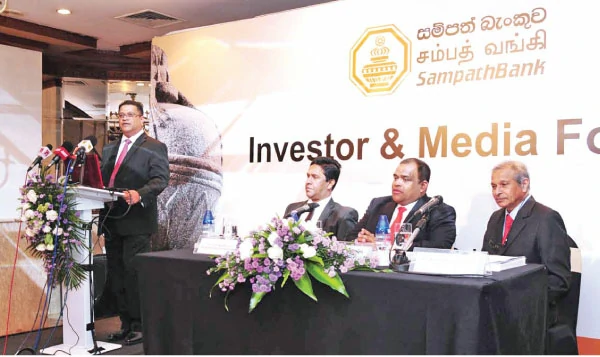
Sampath Bank continued with the growth momentum in 2012, by posting impressive results in many key areas over the last year, amidst many challenges which included a regulatory credit ceiling and pressure on interest margins, resulting from shifting of funds from low cost to high cost deposits in the high interest rate scenario, which prevailed in the market. The Bank’s pre-tax profit which rose to 7,265 million rupees in 2012, reflected an increase of 2,271.4 million rupees or 45.5 percent over the pre-tax profit of 4,993.6 million rupees for the year ended 2011. The post-tax profit of the Bank recorded a growth of 51.6 percent over the same period of last year, rising from 3,387.2 million rupees in 2011 to 5,136.4 million rupees in 2012.
The Pre-Tax Profit of the Group, which consists of Sampath Bank and the four subsidiary companies, amounted to 7,517.5 million rupees for the year ended 2012, reflecting a growth of 2,141.9 million rupees or 39.8 percent, over the pre-tax profit of 5,375.5 million rupees for 2011. The post-tax profit of the Group amounted to 5,346 million rupees, recording a growth of 1,640.5 million rupees or 44.3 percent, over the post-tax profit of 3,705.4 million rupees for the last year.
Net Interest Income, which is the main source of income from the fund based operations and representing over 50 percent of the total operating income, rose from 8,943.3 million rupees in 2011 to 11,612.6 million rupees in 2012, recording a significant growth of 29.8 percent.
Commission and Fee based income of the Bank recorded a growth of 338.4 million rupees or 18.69 percent in 2012 over the previous year, as a result of increased economic activity in the market and the rapid growth achieved by the Bank in its lending activities.
Other income of the bank increased by 289.75 million rupees to 4,107.8 million rupees in 2012 compared to 3,818.1 million rupees in 2011. Bulk of the other income comprised of exchange income which rose from 963.8 million rupees in 2011 to 2,149.4 million rupees in 2012, recording a growth of 1,185.5 million rupees or 123 percent.
Net trading income decreased by 307.7 million rupees mainly due to the recognition of a capital gain in 2011 amounting to 376.8 million rupees by selling the Visa/Master shares held by the Bank, which were received free of charge.
Operating expenses of the Bank rose to 9,396.8 million rupees in 2012, recording an increase of 1,338 million rupees or 16.6 percent compared to 2011. Apart from that, the effect of salary increments during the year and the inflation in the economy too contributed in increasing operating expenses over the previous year.
The growth rates in deposits and total assets in 2012 amounted to 24.34 percent and 24.93 percent respectively and compared well with the industry’s growth rates during the period. In addition, the growth rate in customer advances during the year 2012 amounted to 21.63 percent. The bank was able to exceed the permitted credit growth of 18 percent due to its ability in raising foreign currency funding totalling to USD 62.5 million.
The Bank has one of the lowest impairment ratios in the industry at 1.9 percent. This was mainly due to prudent credit disbursements and competent credit quality management.
Cost/Income ratio rose to a peak level of 61.5 percent in 2011, mainly due to the additional cost incurred with the accelerated branch expansion programme and recruitment of 600 new staff. However, the ratio in 2012 dropped to 59 percent with the moderation in branch expansion programme and the significant increases in the NII and Foreign Exchange Income.
The Statutory Liquid Asset Ratio dropped from 24.95 percent as at December 21, 2011 to 22.4 percent as at December 31, 2012, mainly due to the rapid credit expansion. Though, the ratio was maintained at a reasonably high level over the minimum requirement of 20 percent, it was not as high as the industry average of around 31.2 percent, due to the prudent trade-off maintained between liquid assets and earning assets.
Sampath bank also remained as one of the well capitalised Banks, with the Tier I Capital Adequacy Ratio at 11.80 percent and the Total Capital Adequacy Ratio at 13.61 percent as at December 31, 2012.





